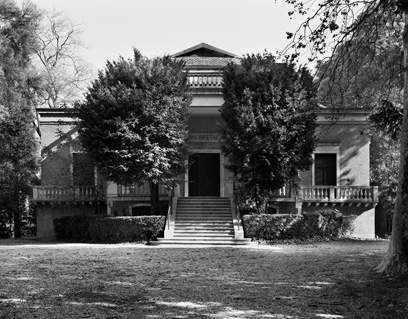
BRITISH PAVILION 1909
EDWIN ALFRED RICKARDS
ON THE VERANDAH
PETER COOK
It is said that dogs grow like their masters and that human couples—if they are together long enough—develop common characteristics and even start to look alike. My hunch is that this has happened, over the many years, to the British Pavilion in the Giardini.
Of course, there is its position: At the end of the rather stony path that leads up to the right as you enter the gardens, past the enduring magic of Sverre Fehn’s Skandinavian Pavilion, past the provocations that are usually to be found in the Japanese and Korean Pavilions, up with a slightly steeper last gasp and you arrive on the mound upon which sit the three old men of Europe. Surely it was a decision of some cynical brilliance that placed the French, the Germans, and the British together. All three pleased with themselves, pleased with their assumption of cultural superiority—despite the more exciting or epoch-making displays that may come—one year or another from a Holland or a Hungary or an Australia or a wherever.
On close inspection of the mound, one discovers there is even a newer, fourth inhabitant—Canada, slyly tucked in between Britain and Germany, unglamorous but with quite often brilliant contents.
We should already be alerted by the basic treatment of neo-Classicism seen in the three old buildings: If the French is correct, the German more spacious but more pompous, it is the British one that is casual in its use of the parti. The main feature (always much in use) is actually the verandah. Perhaps it was this that appealed to the cultural “wallahs” of the Empire who said, “OK, it’s a deal” when offered this former tea-house. Perhaps it resonated in the same manner as some hill-station up from Bombay, its verandah doing nicely for a gin and tonic away from the chattering foreigners.
The other appealing feature might well have been the ground floor. Dark and low, it is rarely used for exhibition purposes but comes into its own for those chicken-drumstick-and-wine occasions (which I notice also attract many punters with no visible connection with the British) on preview days. At other times this floor provides a blessed opportunity to escape or a discreet gossip.
But what of the main rooms? They offer a challenge to the designer and a leveling imposition upon the exhibitor, who can never in this pavilion really do anything that big or that sequential. Like the family dog again, this space is not a hunter, or a show-animal, it has no tremulous bark but rather is friendly, cuddly, and open to gentle abuse. So, some of us have tarted it up with big sloshes of colour (the Brits always take the view that “If in doubt, how about some colour?”). On occasion non-Brits representing Britain have blacked it out. The cool have whitened it out: But then the almost domestic friendliness of it bites back.
Coming from the seaside, I wrapped a large part of it behind a jazzy drape—as we might well do in Blackpool or Brighton. We put deckchairs… on the verandah. (Where else?) We grew tomatoes in the conservatory at the rear. (Why not?)
The part of the building that appeals to a certain instinct of the more romantic, more contemplative British person, the conservatory, has a veiled outlook toward a little local canal and some unremarkable plantation; facing away from the main business of the Biennale, it seems the place to be, still perhaps flummoxed by the intensity of the sun or, in autumn, charmed by the mist.
But in the evenings of the preparation days (that best part of the whole Biennale experience, with the best gossip and the best anecdotes and before the real public come through) the Brits will swop wine, banter, pizzas, or even girlfriends and boyfriends with the French and the Germans. Curiously, but almost consciously, the three pavilions create a little enclave of their own, in which one may drop by one of the neighbours’ to borrow a screwdriver and end up with them for the evening.
There is a wonderful, underused word in the English language: ”fusty.” It means old, behind the times, unkempt, dowdy, even possibly tacky… but not quite. Even slightly lovable. Despite the efforts of some very clever curators and very talented exhibitors, it is this quality of the fusty that remains with the building. It is often the British souvenir bag that is recommended across the Giardini, but rarely the building.
But then, we were always regarded as a nation of shopkeepers… oh, and a gin and tonic would be very nice, thanks.